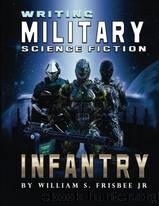Writing Military Science Fiction: Infantry by William S. Frisbee Jr

Author:William S. Frisbee Jr. [Frisbee, William S. Jr.]
Language: eng
Format: epub
Tags: Writing
ISBN: 9781979148955
Google: pi_qtAEACAAJ
Goodreads: 38902563
Publisher: CreateSpace Independent Publishing Platform
Published: 2018-01-31T00:00:00+00:00
4.2.13
TACTICS â PATROLLING
Patrols are some of the most important combat operations conducted. A patrol can be anywhere from a fireteam in size to a battalion. The mission often determines the size of the patrol.
Patrolling is a general term used to describe a unit that is on the move and is doing something other than attacking a fixed enemy position. Patrol formations are often used during movement in hostile terrain.
There are six types of patrols recognized in USMC handbooks. The acronym used is RACESS or CARESS. This stands for Recon, Ambush, Contact, Economy of Force, Security and Search and Attack. Recon patrols are also broken down into three subcategories, point, area and route.
The mission of the patrol heavily influences how it is organized and how it will react to enemy contact. Not all patrols will stand and fight, even if they are superior to the enemy. A lot of planning goes into patrols. Entire manuals have been written on how to conduct and plan for patrols. This section is not nearly big enough to cover all the different aspects, but it will cover some of the more important ones.
All patrols have several things in common. They must go into the combat zone, avoid getting lost while in it, and get out of the combat zone without getting shot by friendly forces, and hopefully enemy forces.
Most patrols leave from friendly lines, a position protected by mines, booby traps, barbed wire and machine guns. Then the patrol must come back to a different route to avoid getting ambushed by an enemy that saw them leave. This requires coordinating with the front-line units, so the patrol is guided out safely and back in safely. Usually, when a patrol comes back in, they radio ahead, and a guide is sent out into no-man's-land to guide them back in. Due to the possible presence of enemy forces this is a scary operation, especially when it is done at night. You never know if those people you are approaching are friendly or enemy.
Passwords, locations and other relevant data is important. When a patrol leaves friendly lines, it is possible they might get attacked and be forced to retreat. Retreating through an unfamiliar minefield is a nightmare and can be quite fatal. Getting reinforcements outside the defensive barriers is also not easy because the route out is usually narrow and one enemy sniper could shut it down.
Once a patrol has safely gotten out of friendly lines, it must move quietly and avoid getting ambushed. To avoid getting ambushed and to keep the enemy from guessing where they are going if they are seen, a zig zag line is used to reach the objective or to travel the patrol route.
Instead of departing friendly lines a patrol may be inserted into their patrol area by truck, IFV, boat, helicopter, SCUBA, etc.
During the patrol the leader will frequently stop the patrol, so they can listen to their surroundings, and take a break or drink water. Usually during extended breaks, the patrol leader will find a hiding spot and establish a perimeter.
Download
This site does not store any files on its server. We only index and link to content provided by other sites. Please contact the content providers to delete copyright contents if any and email us, we'll remove relevant links or contents immediately.
Wonder by R.J. Palacio(7724)
Unlabel: Selling You Without Selling Out by Marc Ecko(2975)
POP by Steven Heller(2878)
Hidden Persuasion: 33 psychological influence techniques in advertising by Marc Andrews & Matthijs van Leeuwen & Rick van Baaren(2771)
The Pixar Touch by David A. Price(2736)
Ogilvy on Advertising by David Ogilvy(2677)
Drawing Cutting Edge Anatomy by Christopher Hart(2671)
Slugfest by Reed Tucker(2412)
The Art of War Visualized by Jessica Hagy(2408)
The Curated Closet by Anuschka Rees(2379)
Stacked Decks by The Rotenberg Collection(2266)
The Wardrobe Wakeup by Lois Joy Johnson(2228)
365 Days of Wonder by R.J. Palacio(2227)
The Code Book by Simon Singh(2204)
Rapid Viz: A New Method for the Rapid Visualization of Ideas by Kurt Hanks & Larry Belliston(2189)
Tell Me More by Kelly Corrigan(2189)
Keep Going by Austin Kleon(2154)
Tattoo Art by Doralba Picerno(2079)
Tokyo Geek's Guide: Manga, Anime, Gaming, Cosplay, Toys, Idols & More - The Ultimate Guide to Japan's Otaku Culture by Simone Gianni(1941)
